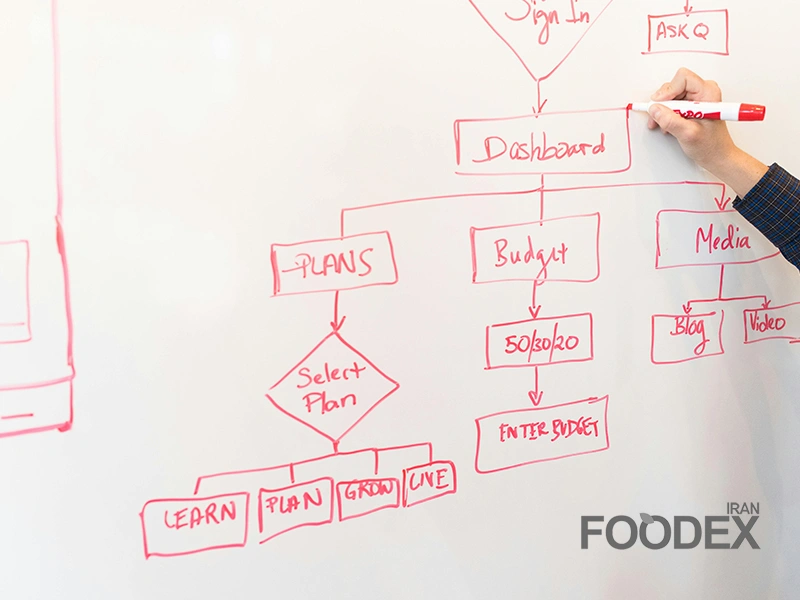Food industry demand planning is one of the most complex supply chain tasks due to its products quickly spoiling, market changes and season impacts, and unpredictable customer request patterns.
Inaccurate demand forecasting results in supply shortages, wasted food products, higher expenses, and dissatisfied customers, while also creating multiple difficulties for proper planning.
Foodex Magazine produces this paper, which investigates the major difficulties faced by food industry demand planners and offers solutions for their management.
This analysis also covers the methods used by Arvin Food to address its challenges in producing organic food products.
1- Demand Variability
The food industry experiences demand variations because of various elements, such as changing food trends and ongoing marketing activities, market conditions, shifts in consumer buying habits, and seasonal pattern changes.
Strategies for Identifying and Managing Demand Variability in the Food Industry
The company uses statistical models to recognize seasonal patterns together with demand variations.
Proper forecasting accuracy becomes possible by combining historical information with recently captured datasets.
Analyzing customer feedback and sales activity enhances prediction accuracy for market demand.
Example: Managing Demand Variability at Arvin Food
Summer drives increased sales of natural fruit juices at Arvin Food since the company operates within the organic food manufacturing sector.
The data analysis team implements hybrid forecasting models to help determine the seasonal effect on sales and marketing processes and adjust manufacturing output.
2- Lack of Data Quality
Forecasting errors will occur when data is either inaccurate or incomplete, thus causing inventory shortages and food waste.
Strategies for Improving Data Quality in the Food Industry
Businesses should improve their data collection processes by installing integrated data management systems.
Assessment and fixing data problems enable better forecasting results.
The analysis software identifies data quality issues so the company can resolve them effectively.
Example: Managing Data Errors at Arvin Food
The analytics team identified incorrect order recording during their inspection of sales data.
Smart data analytics software implementation followed an integration of the order and sales management system at Arvin Food.
3- Forecast Bias and Accuracy Measurement
Disrupted supply chains result from continuous forecasts that reflect either optimistic (positive bias) or pessimistic (negative bias) predictions.
Strategies for Managing Forecast Bias and Accuracy in the Food Industry
The company maintains a routine analysis of forecasting precision alongside updates made to model algorithms through fresh information.
Professional forecast assessment relies on Mea Absolute Percentage Error (MAPE) performance metrics.
Accurate correction methods for detecting and eliminating problems with forecasting models.
Example: Managing Forecast Errors at Arvin Food
The organic olive oil demand predictions at Arvin Food were higher than the recorded market sales.
Adjusting forecasting models and error analysis led to a 15% increase in accuracy rates.
4- Collaboration and Communication
Technical specification problems between demand forecasting teams, such as marketing, sales, and supply chain, result in forecasting difficulties.
Strategies for Enhancing Cross-Team Coordination in the Food Industry
Businesses should assemble groups of team members from different departments who work together to manage demand planning decisions.
The organization utilizes digital platforms to distribute real-time data among different departments.
The organization requires enhanced cooperation between its production units and distribution infrastructure alongside sales network teams.
Example: Managing Team Coordination at Arvin Food
The sales manager’s large-scale advertising push for plant-based milk occurred independently of the supply chain department’s input.
The combination led to significant stock deficits throughout the company.
Arvin Food deployed a cloud-based information sharing platform as a direct result of that operational mistake.
5- External Factors
Economic crises, trade barriers, currency instability, and natural disasters affect total supply and overall market demand.
Strategies to Mitigate the Impact of External Factors in the Food Industry
Economic indicators and their influence on consumer purchasing habits must be analyzed through ongoing observation.
The organization should create crisis management plans that cover various market conditions.
The implementation of backup supply networks helps decrease dependency on one sole supplier.
Example: Managing External Factors at Arvin Food
When the region suffered from a drought, organic wheat prices dramatically increased.
The procurement team investigated neighboring domestic suppliers to reduce the damaging effects.
6- Supply Chain Disruptions
Issues with suppliers, transportation delays, or global crises can disrupt the supply chain.
Strategies for Reducing Supply Chain Disruptions in the Food Industry
The company must always keep enough inventory of essential raw materials.
The company obtains agreements with several suppliers to decrease its dependence on any single vendor.
Organizations leverage data analytics with digital instruments to monitor upcoming risks and possible delays.
Example: Managing Supply Chain Disruptions at Arvin Food
The COVID-19 pandemic brought success to Arvin Food because it secured multiple parallel suppliers to keep its raw material supply flowing continuously.
7- New Product Introductions
The scarcity of historical information about new product demand creates substantial difficulty for forecasters.
Strategies for Forecasting New Product Demand in the Food Industry
The company should perform market research and compare existing product patterns.
The company uses controlled tests across small markets to collect necessary information.
The company uses customer feedback together with preliminary sales performance to improve future forecasting methods.
Example: Managing New Product Demand at Arvin Food
The launch of its new plant-based yogurt began with store distribution, which allowed Arvin Food to adjust manufacturing quantities according to the acquired initial sales data.
8- Short Product Lifecycle
The food industry contains numerous products that run through short life cycles because consumer demand patterns quickly change.
Strategies for Managing Short Product Lifecycles in the Food Industry
The company utilizes real-time sales data to determine correct production and distribution workflow adjustments.
The company works with suppliers who maintain adjustable operations to manage fast market adjustments quickly.
Organizations should use marketing efforts along with discounting solutions to stop stockpiling.
Example: Managing Short Product Lifecycle Challenges at Arvin Food
The probiotic beverage industry experienced declining demand, so Arvin Food adopted social media marketing, which drove better sales results.
9- Multi-Channel Sales
Managers face difficulties when they need to manage sales demand between physical stores, online platforms, and retail partner operations simultaneously.
Strategies for Managing Multi-Channel Sales in the Food Industry
Implementing integrated inventory management systems.
Companies need to track sales performance between channels to make necessary changes in their supply operations.
Managers should distribute stock between their diverse sales platforms to maximize their impact.
Example: Managing Multi-Channel Sales Challenges at Arvin Food
The growing volume of online orders left physical stores with additional stock they could not move.
The team behind the planning phase developed a system to unite inventory management operations that allowed optimized stock distribution across multiple channels.
10- Global Supply Chain Management in the Food Industry
Companies that buy their raw materials from foreign suppliers must deal with international laws, currency market shifts, import taxes, and nation-level political events.
Fluctuations in these raw materials factors create effects that disrupt material availability, price costs, and delivery period requirements.
Strategies for Managing Global Supply Chain Challenges in the Food Industry
Organizations should monitor international developments alongside trade agreements to detect possible interruptions in their raw materials supply.
The company supports diverse supplier networks by working with producers across various regions to decrease dependence on one primary supply source.
Forecasts are executed through systems that handle multiple currencies and languages to control price shifts alongside exchange rate uncertainties.
The company decreases supply risks by signing long-term buying agreements and storing vital raw materials in strategic stockpiles.
Example: Managing Global Supply Chain Challenges at Arvin Food
Arvin Food, an organic food producer, sources organic almonds and natural honey from suppliers in Turkey and Spain.
The company’s wholesale prices of essential raw materials rose during the previous financial year due to foreign currency changes and new import regulations.
The procurement team reacted to the challenge in the following manner:
The company redistributed some of its material supply to local suppliers to decrease import dependence.
The company protected itself against price variations through multi-year business agreements with global suppliers.
The company utilized financial management tools that operate with multiple currencies to achieve optimal foreign currency conversion rates.
The company expanded its supply network through supplier negotiations with Uzbekistan and Georgia.
As a result, Arvin Food successfully controlled procurement costs and ensured uninterrupted production.
Conclusion
Current market conditions, seasonal patterns, consumer buying habits, delivery problems, and worldwide uncertainties shape the highly complex food supply chain demand planning procedures in this quickly changing world.
Companies that want improved forecasting results and optimized inventory levels must use sophisticated analytical models and real-time data while implementing cross-functional teamwork and contemporary technology resources.
The combination of supplier diversity, smart inventory control practices, a supply chain optimization strategy, and combined forecasting approaches assists food businesses in reducing costs without compromising customer service standards.
Success in demand planning produces multiple benefits, including reduced costs and safeguarding against inventory shortages, which concurrently boost operations, supply chain adaptability, and firm performance.
Ehsan Allahverdi
Executive Manager of Foodex Iran
Marketing Consultant for Leading Food & Beverage Brands
website | linkedin
























